|
|
 |
Fiche d'espèce de Copépode |
|
|
Calanoida ( Ordre ) |
|
|
|
Diaptomoidea ( Superfamille ) |
|
|
|
Acartiidae ( Famille ) |
|
|
|
Acartia ( Genre ) |
|
|
|
Acanthacartia ( Sous-Genre ) |
|
|
| |
Acartia (Acanthacartia) tsuensis Ito, 1956 (F,M) | |
| | | | | | | Ref.: | | | Ito, 1956 (p.470, figs.F,M); Greenwood, 1972 (p.317); Takahashi & Ohno, 1996 (p.125, figs. Nauplius, juv., F,M); Chihara & Murano, 1997 (p.671, Pl.20: F,M); Blanco-Bercial & al., 2014 (p.6, Rem.: problematical for barcoding); Ueda, 2024 (p.118-120, figs.F,M) |  issued from : T. Ito in Pacif. Sc., 1956, 10 (4). [p.471, Fig.2]. Female (from brackish ponds, Kumozu and Heta regions, middle Japan): a, habitus (dorsal); b, last thoracic segment and urosome (dorsal); c, forehead (ventral); d-g, P1 to P4; h, P5. Nota: Head and 1st thoracic segment separated, 4th and 5th fused. A1 17-segmented, reaching to middle portion of genital segment. Rostral filaments more slender than in A. iseana ( = A. sinjiensis). Last two thoracic segments fused, lateral angle rounded with 6 spinules on either side. Genital segment scarcely longer than other two abdominal segments combined ; first two abdominal segments each with 6 spinules along distal margins of dorsal surface. Caudal rami rather shorter than that of A. iseana ( = A. sinjiensis), 1.5 times as long as wide. P5 with basal segment longer than wide, outer seta rather slender and long ; exopodite unsegmented, proximal portion wider than distal spine, about 2 times as long as wide, bearing well-developeed, pointed process on outer edge ; terminal spine curved inwards midway, without spinules on either side Male: i, P5. Nota : P5 : Right leg with basal segment longer than wide (about 2 :1) ; lengths of basal segment and exopodite 1 and 2 (in micrometers) as 39 :42 :39 ; inner margin of exopodite 1 smooth ; inner lobe of exopodite 2 very prominent, about as long as wide, its top not bifurcate ; exopodite 3 very narrow at base, curved, without spines on outer margin, but with a spine on inner edge as in A. iseana ( = A. sinjiensis). Left leg : lengths of basal segment and exopodite 1 and 2 (in micrometers) as 46 :31 :26 ; basal segment rather slender, about 2 times as long as wide ; exopodite 1 very simple and smooth ; exopodite 2 consisting of 2 portions, proximal protuberance bearing a slender spine on inner margin and narrower distal portion with small spine on top and subapical small process.
|
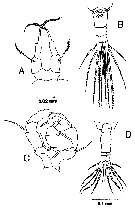 issued from : T. Takahashi & A. Ohno in J. Oceanogr., 1996, 52 [p.128, 129, Figs.2, 3]. Female (from Momoshima station, coastal saltwater pond): A, P5; B, urosome (dorsal). Nota: In the adult female of A. tsuensis, the terminal spine of the exopod of P5 is apparently more slender than in A. omorii.
Male: C, P5; D, urosome (dorsal). The adult male of A. tsuensis possesses apparently curved setae on the caudal ramus , while they are nearly straight in A. omorii. In the adult male of A. omorii, the inner projection developed in the second segment of the right P5 exopod is bifurcated, while it is not bifurcated in A. tsuensis.
|
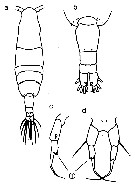 Issued from : M. Chihara & M. Murano in An Illustrated Guide to Marine Plankton in Japan, 1997. [p.678, Pl. 20, fig.10 a-d]. Female: a, habitus (dorsal); b, last thoracic segment and urosome (dorsal); c, P5 (lateral view); d, P5. Nota: numbers show characteristics of this species to compare with A. sinjiensis.
|
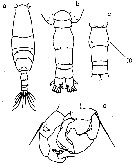 Issued from : M. Chihara & M. Murano in An Illustrated Guide to Marine Plankton in Japan, 1997. [p.678, Pl. 20, fig.10 a-d]. Male: a, habitus (dorsal); b, last thoracic segment and urosome (dorsal); c, same (part., ventral); d, P5. Nota: numbers show characteristics of this species to compare with A. sinjiensis.
| | | | | Ref. compl.: | | | Uye S-i., 1982 (p.149, relation length-weight-C-N); Ohno & Okamura, 1988 (p.39); Oka & Saidho, 1994 (p.51, abundance); Ohtsuka & al., 1995 (p.159); Madhupratap & al., 1996 (p.77, Table 2: resting eggs); Marcus, 1996 (p.143); Golez & al., 2002 (p.341, population dynamic, , abundance, development vs salinity, fecundity); Mauchline, 1998 (tab.33, 35, 36, 40, 47, 51); Lo & al., 2004 (p.468, tab.2); Kurihara & al., 2004 (p.721, CO2 effects); Kurihara & Ishimatsu, 2008 (p.1086, Rem: CO2 effects); Ohtsuka & al., 2008 (p.115, Table 5); Sakaguchi & al., 2011 (p.18, Table 1, 2, occurrences); Ohtsuka & Nishida, 2017 (p.565, 578, Table 22.1); | | | | NZ: | 3 | | |
|
Carte de distribution de Acartia (Acanthacartia) tsuensis par zones géographiques
|
| | | | | | 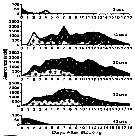 Issued from : S.N. Golez, A. Ohno, J.D. Toledo, Y. Tanaka & T. Ishimaru in Fisheries Sc., 2002, 68 (Supplt. 1) [p.343, Fig.5] Issued from : S.N. Golez, A. Ohno, J.D. Toledo, Y. Tanaka & T. Ishimaru in Fisheries Sc., 2002, 68 (Supplt. 1) [p.343, Fig.5]
Development of A. tsuensis in various salinities.
Dotted light and dark-colored regions reppresent the abundance of eggs-nauplii, and copepodites, respecrively.
Sampling site: a brackish-water pond (Guimbal pond in Panay Island, central Philippines).
psu x 0.36 = chlorinity, and Salinity = 0.030 + 1,805 Cl.
Nota: the results of the experiment on the effects of salinity on the population parameters show that copepods reared in 12, 22 and 32 psu propagated while those cultured in 2 and 42 ppu did not survive beyond day 5. |
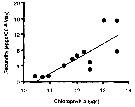 Issued from : S.N. Golez, A. Ohno, J.D. Toledo, Y. Tanaka & T. Ishimaru in Fisheries Sc., 2002, 68 (Supplt. 1) [p.343, Fig.6] Issued from : S.N. Golez, A. Ohno, J.D. Toledo, Y. Tanaka & T. Ishimaru in Fisheries Sc., 2002, 68 (Supplt. 1) [p.343, Fig.6]
Relationship between fecundity of female and chlorophyll a in Guimbak pond.
Fecubdity has a positive linear correlation with chlorophyll a ranging from 12-14 µg/l. |
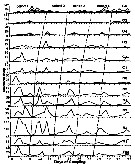 Issued from : S.N. Golez, A. Ohno, J.D. Toledo, Y. Tanaka & T. Ishimaru in Fisheries Sc., 2002, 68 (Supplt. 1) [p.343, Fig.1] Issued from : S.N. Golez, A. Ohno, J.D. Toledo, Y. Tanaka & T. Ishimaru in Fisheries Sc., 2002, 68 (Supplt. 1) [p.343, Fig.1]
Stage-specific abunndance in Guimbal pond in November 1998- January 1999.
The lines traversing the plots are boundaries of the cohorts. The shaded and unshaded portion in the C4-C6 stages denote female and male, respectively.
Nota: The year-long survey of the zooplankton composition of Guimbal pond showed that A. tsuensis was dominant during the dry season when the salinity is in the range of 14-40 ppt;
The duration of the egg and the first nauplius (N-I) stage varied among cohorts, from 10.4 hr to 33.6 hr and 2.4 hr to 28.8 hr, respectively. The rate of development from the nauplius 2 (N-II) through to copepodite 5 (C-V) satges was observed to develop at an almost constant rate (isochronal development) in two cohorts in the pond. The stage duration of individuals undergoing isochronal development ranged from 4.9-16.6 hr while that of adults was between 33.6-72 hr. Generation time among cohorts were estimated to be 5.9, 8.7, 6.3 and 11.3 days for cohorts 1, 2, 3, and 4, respectively. The recruitment of individuals decreased exponentially through the succeeding stages. |
| | | | Loc: | | | Japan (Nansei Islands, Kyushu : Sumiyo Bay, Seto Inland Sea [Fish ponds in brackish waters], Hiroshima, eel farming pond in Matsusaka City, Momoshima Island, mouth of Souzu River), S Korea, China Seas (East China Sea),Taiwan (Tapong Bay), Philippines (Panay Is.) | | | | N: | 9 | | | | Lg.: | | | (189) F: 0,992-0,893; M: 0,868-0,818; (866) F: 0,9-1; M: 0,8-0,9; (1324) F: 0,97-1,05; M: 0,67-0,93; {F: 0,893-1,05; M: 0,67-0,93} | | | | Rem.: | saumâtre
Voir aussi les remarques en anglais | | | Dernière mise à jour : 12/09/2024 | |
|
|
 Toute utilisation de ce site pour une publication sera mentionnée avec la référence suivante : Toute utilisation de ce site pour une publication sera mentionnée avec la référence suivante :
Razouls C., Desreumaux N., Kouwenberg J. et de Bovée F., 2005-2025. - Biodiversité des Copépodes planctoniques marins (morphologie, répartition géographique et données biologiques). Sorbonne Université, CNRS. Disponible sur http://copepodes.obs-banyuls.fr [Accédé le 03 juillet 2025] © copyright 2005-2025 Sorbonne Université, CNRS
|
|
 |
 |










